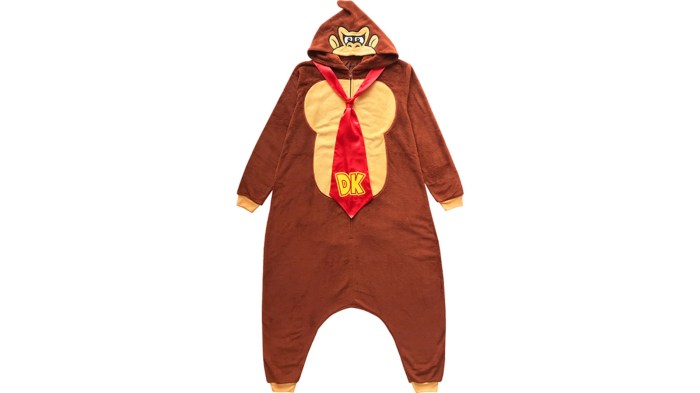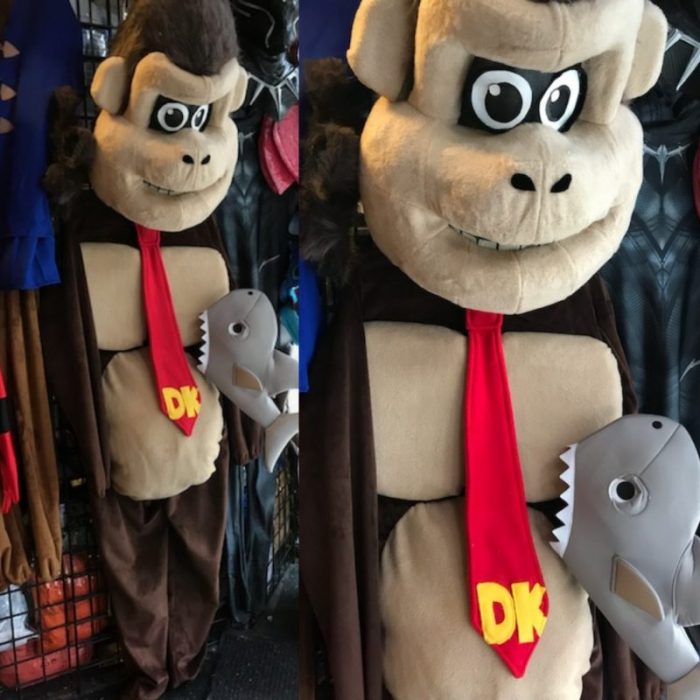DIY Donkey Kong Costume: Want to unleash your inner ape and channel the iconic video game character? This guide will take you through the process of creating a fantastic Donkey Kong costume, from crafting the iconic barrel to assembling the headpiece. We’ll delve into the details of Donkey Kong’s design, providing step-by-step instructions and creative tips to bring your vision to life.
Table of Contents
From the iconic barrel-throwing stance to the signature brown fur and red tie, we’ll cover everything you need to create a costume that captures the essence of Donkey Kong. Whether you’re a seasoned crafter or a beginner, this guide will provide you with the tools and knowledge to embark on your DIY adventure.
Creating the Donkey Kong Headpiece

The Donkey Kong headpiece is the centerpiece of your costume, demanding meticulous attention to detail and construction. This section will guide you through the process of crafting a realistic headpiece that captures the essence of the iconic video game character.
Crafting the Head Form
Start by creating the foundation for your headpiece: the head form. This will serve as the base for attaching the fur and other details.
* Materials: You can use various materials to create the head form, such as:
* Cardboard: This is a readily available and inexpensive option. Use thick cardboard and multiple layers for strength and durability.
* Foam: Craft foam or upholstery foam is a lightweight and flexible option.
* Papier-mâché: This traditional method involves layering strips of paper and glue over a balloon or other form.
* Shaping:
* Cardboard: Cut and shape cardboard pieces to create the basic form of the head. You can use a template or draw directly onto the cardboard.
* Foam: Use a craft knife to carve and shape foam into the desired form.
* Papier-mâché: Inflate a balloon to the size of your head and cover it with layers of papier-mâché.
* Tips:
* Reference Images: Use reference images of Donkey Kong’s head to ensure accurate proportions.
* Smooth Surface: Ensure the surface of the head form is smooth and even to facilitate attaching the fur.
Attaching the Fur, Diy donkey kong costume
Attaching the fur is a crucial step in creating a realistic Donkey Kong headpiece.
* Fur Material:
* Faux Fur: This is the most common and accessible option. Choose a faux fur that closely resembles Donkey Kong’s brown fur.
* Real Fur: If you’re comfortable using real fur, select a type with a similar texture and color to Donkey Kong’s fur.
* Attaching Methods:
* Glue: Use a strong fabric glue to attach the fur to the head form. Apply glue to the head form in sections and press the fur into place.
* Stapling: For thicker fur, you can use a staple gun to secure the fur to the head form. Ensure the staples are hidden under the fur.
* Tips:
* Layering: For a more realistic look, layer the fur in different directions to create depth and texture.
* Trimming: Trim any excess fur to create a clean and defined look.
Crafting the Iconic Nose and Ears
Donkey Kong’s nose and ears are defining features of his appearance.
* Materials:
* Foam: Craft foam is a good option for sculpting the nose and ears.
* Cardboard: You can also use cardboard for a simpler approach.
* Shaping:
* Nose: Cut out a triangular shape from foam or cardboard and shape it into a rounded nose.
* Ears: Cut out two oval shapes from foam or cardboard and shape them into the distinctive Donkey Kong ears.
* Attaching:
* Glue: Use strong fabric glue to attach the nose and ears to the head form.
* Pins: You can use pins to temporarily hold the nose and ears in place while the glue dries.
* Tips:
* Detailing: You can add additional details to the nose and ears, such as wrinkles or texture, using modeling clay or paint.
Creating a Secure and Comfortable Fit
The headpiece should be secure and comfortable to wear.
* Head Size: Measure the circumference of your head and adjust the head form accordingly.
* Weight Distribution: Ensure the weight of the headpiece is evenly distributed to prevent discomfort.
* Straps: Attach adjustable straps to the headpiece using buckles or Velcro.
* Padding: Add padding to the inside of the headpiece for comfort and to absorb sweat.
Adding Additional Details
Incorporate additional details to enhance the realism of your Donkey Kong headpiece.
* Sculpted Brow: Use modeling clay or foam to sculpt a prominent brow over Donkey Kong’s eyes.
* Textured Fur: Create texture in the fur using a variety of techniques, such as:
* Shaving: Shave the fur in different directions to create depth and texture.
* Heat Styling: Use a heat gun or hairdryer to style the fur into a more realistic look.
* Detachable Tongue: Create a detachable tongue using foam or fabric. Attach it to the headpiece with Velcro or magnets.
Constructing the Iconic Barrel Prop: Diy Donkey Kong Costume

No Donkey Kong costume is complete without the iconic barrel prop. This essential element adds to the authenticity and playfulness of your costume, allowing you to interact with your surroundings and create a truly immersive experience.
Constructing a Realistic Barrel Prop
To achieve a realistic barrel prop, you’ll need to carefully consider the shape, materials, and details. Here’s a step-by-step guide to constructing your own barrel:
Materials
* Cardboard: Use sturdy cardboard, like that found in appliance boxes or large shipping boxes.
* Duct tape: This will be used to secure the cardboard and create a smooth, finished surface.
* Paint: Choose brown or a slightly weathered brown paint to achieve a realistic barrel look.
* Optional: Wood stain, acrylic paint, or other materials to add texture and detail.
Cutting and Shaping the Cardboard
1. Create the barrel shape: Cut two large circles of cardboard for the top and bottom of the barrel. These should be slightly larger than the desired diameter of the barrel.
2. Form the sides: Cut strips of cardboard for the sides of the barrel. These should be long enough to wrap around the circles and slightly taller than the desired height of the barrel.
3. Secure the sides: Use duct tape to attach the strips of cardboard to the circles, creating a cylindrical shape.
4. Create a smooth surface: Apply duct tape over the entire surface of the barrel, ensuring that all seams are covered.
Adding a Secure and Sturdy Base
1. Reinforce the bottom: Cut a large circle of cardboard and attach it to the bottom of the barrel using duct tape. This will add extra stability and strength to the base.
2. Consider a base stand: For added stability, you can create a base stand using a piece of wood or thick cardboard. This will prevent the barrel from tipping over.
Adding Details and a Realistic Barrel Opening
1. Paint the barrel: Apply a base coat of brown paint to the entire barrel. Let the paint dry completely before proceeding.
2. Add texture and detail: Use a sponge or brush to apply wood stain or acrylic paint to create a weathered look. You can also add details like metal bands or a wooden rim to the barrel opening.
3. Create a realistic barrel opening: Cut a rectangular opening in the top of the barrel. You can use a sharp knife or utility knife for this.
Designing the Barrel for Comfort and Practicality
1. Weight distribution: Ensure the weight of the barrel is evenly distributed to prevent discomfort while carrying. You can adjust the thickness of the cardboard or add additional support to the base to achieve this.
2. Handle placement: Create a comfortable handle for carrying the barrel. Consider using a strong rope or a sturdy piece of wood. The handle should be placed in a position that allows for a secure grip.
3. Safety: Ensure the handle is securely attached and that the barrel is sturdy enough to withstand throwing. Consider using additional reinforcement if necessary.
Creating a Functional Barrel for Throwing Props
1. Choose appropriate materials: Use lightweight materials like cardboard or foam for the barrel to minimize the risk of injury when throwing.
2. Consider the weight of the prop: If you plan to throw objects, ensure that the barrel is strong enough to handle the weight and impact.
3. Practice safe throwing techniques: Always throw the barrel in a safe direction and ensure that there are no obstacles in the way.
Creating a Functional Barrel for Throwing Props
To create a functional barrel that can be used for throwing props, consider using lightweight materials like cardboard or foam. This will minimize the risk of injury when throwing. Ensure that the barrel is strong enough to handle the weight and impact of the props you plan to throw. Practice safe throwing techniques and always throw the barrel in a safe direction, ensuring there are no obstacles in the way.
With a little creativity, patience, and the right materials, you can create a DIY Donkey Kong costume that will turn heads and transport you to the world of video game nostalgia. Remember, the key is to embrace your inner ape, channel your creativity, and have fun with the process. So grab your tools, gather your materials, and get ready to unleash your inner Donkey Kong!
A DIY Donkey Kong costume can be a fun project, especially if you’re looking for a unique and memorable look. You’ll need to find some brown fabric, a barrel for your chest, and maybe even a banana for your hand. If you’re feeling ambitious, you could even make a DIY detox drink like this one to cleanse your system after all that crafting.
Once you’re done, you’ll be ready to jump around and collect barrels like the classic video game character.

